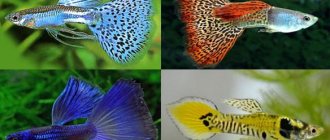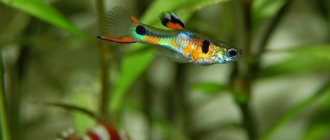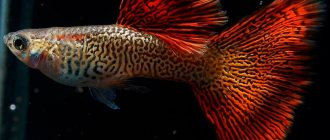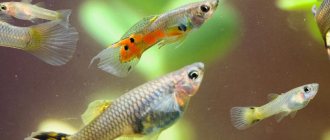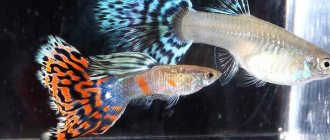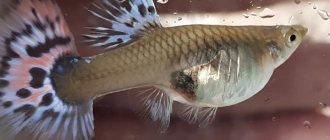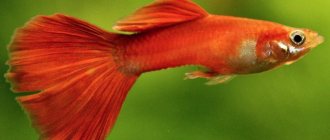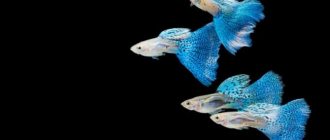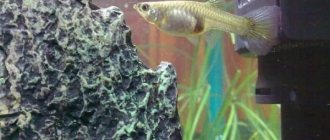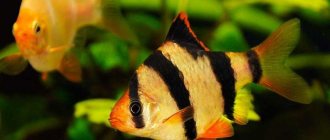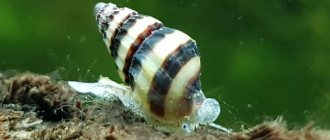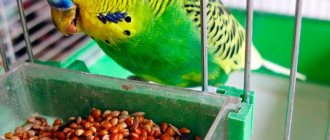What do guppies eat in the wild?
In warm freshwater or brackish waters of Guyana, Brazil, Venezuela, where guppies come from, they feed on the larvae and eggs of mosquitoes and mosquitoes. The smallest representatives of river fauna are used as food: crustaceans, ciliates, and fry of other fish species. Guppies eat various algae, so in aquarium conditions the diet should consist of both protein live food and plant components.
Wild guppies in their natural habitat.
Small, unpretentious fish will forgive the owner for minor changes in the environment, lack of sophistication in the aquarium and errors in maintenance. The only condition for comfortable cohabitation will be proper fractional nutrition, alternating the necessary components. It is not difficult to diversify the guppies' menu - they are ready to eat any type of food: live and specialized, from the store. Growth, brightness of color, and reproductive function depend on the diet . Beginner aquarists should know what to feed guppies and what food is preferable for them.
Compatibility of guppies with other fish
Any fish that is more or less capable of standing up for itself can offend a guppy. Therefore, it is necessary to keep guppies only with 100% peaceful animals living in similar conditions. However, in nature, nothing happens 100% and there are cases where guppechs coexisted quite peacefully with predators, but at the same time, friction arose in the company of their own kind.
Fish that are suitable for keeping with guppies:
- Mollies
- Swordtails
- Neons
- Pecilia
- Danio
- Ternetia
- Small tetras
Well, what about the bottom inhabitants, who are unlikely to intersect with your pets:
- Small catfish
- Shrimps
Guppies are relatively compatible with labeo, gouramis, barbs and even knifefish. Most likely, the fish will be safe among them if this whole crowd grows together.
Essential microelements
The need for vitamins depends on age, weight, growth rate, health status, and level of productivity. For normal growth, development, and healthy offspring, guppies must receive food that maintains a balance of vitamins and microelements. The food must contain:
- Water-soluble B vitamins and vitamin C, which activate metabolism and the activity of enzyme systems.
- Fat-soluble A, D, E, K, affecting protein, fat and mineral metabolism.
- Vitamins E and C, antioxidants.
- Calcium, which ensures bone strength, participates in the processes of muscle contraction and blood clotting.
- Phosphorus for complete digestion of food. Regulates hormonal levels, takes part in the transmission of hereditary information. The need for phosphorus is observed in young guppies at the stage of skeletal ossification.
- Magnesium, responsible for the neuromuscular system of fish. It is involved in osmoregulation and the breakdown of nucleic acids.
- Cobalt – healthy immunity.
- Iodine is an integral part of thyroid hormones.
- Manganese, which protects the liver from fatty degeneration, is involved in tissue respiration and reproductive function.
- Iron for respiration and oxidative processes.
- Cobalt, which prevents anemia, affects the exchange of nitrogen in nucleic acids.
Selenium deficiency is the cause of pathologies in the cells of the spinal cord and liver, which leads to the death of fish. Zinc deficiency affects hematopoiesis, vision, reproduction, development and growth.
Males have bright fins and to maintain color they are given carotenoids and special additives 2-3 times a week.
Components in the diet
Guppies are omnivorous fish, i.e., the stable performance of their body is based on the assimilation of protein and plant foods. If the food does not contain the necessary vitamins/elements, they are compensated by special additives in the water.
Guppies need:
- Squirrels. Serve to obtain energy and for the growth of body tissues. It is best absorbed from animal foods. Plant-based is not so good. The norm in the diet is 25–30% protein. In fry and pregnant females - 40–50%.
- Fats. This is a backup source of energy. Serves for metabolism. 5–8% in the feed is a sufficient amount of the component. The main intake is animal food.
- Carbohydrates. This is a source of fast energy. The norm is 20% in the guppy diet. Necessary for moving food through the intestinal tract.
- Macro and microelements. Many elements of the chemical table are needed by a living organism for a healthy existence. Guppies are no exception. Macro and microelements are components of a complete diet. And the fish additionally receives them from the environment (water).
We must not forget about vitamins. They ensure metabolism in the body. Each performs its own function:
- vitamin B - obtaining energy and nutrition for the central nervous system;
- B2 - protein digestion;
- B5 - enzyme synthesis;
- B6 - functioning of the nervous system;
- B12 - work of the digestive system and hemoglobin synthesis;
- A - vision, growth, protection of the mucous membrane;
- vitamin C is responsible for skeletal growth and immunity;
- D3 helps absorb calcium and phosphorus, etc.
Dry food: which one to choose
The variety of offers makes the guppy's diet rich and not boring. The assortment includes dust, flakes, granules, tablets. There are single-ingredient feeds, and there are complex ones, with vitamin supplements, of plant and animal origin. Manufacturers made sure that the guppy was not only well-fed, but also had the appropriate color, activity, and fertility. Among the popular brands:
Tetra
A German company that sells a variety of feed and other related products for all types of fish. The advantage is a wide selection and affordable price. Flakes, tablets of plant and animal origin, as well as fish treats from Tetra undergo mandatory certification .
Hikari
The brand belongs to a Japanese manufacturer that supports the health of fish with high-quality food. The company's laboratories are working on formulas that are used in accordance with the age, needs and developmental characteristics of fish. Dry vegetable chips, sinking tablets, frozen larvae, mineral supplements do not cause damage to aquarium water and maintain the tone of the fish.
Aquarian
American manufacturer supplying tested quality fish food. The only drawback is that there are no representative offices in Russia, but this does not stop aquarists: they find the company’s distributors or place orders via the Internet.
Sera
German brand food is distinguished by its low price and variety. It is not a problem to buy food in a 10-gram bag and in a 10-kilogram bucket. The assortment includes flakes, granules, etc.
Aller Aqua
Manufacturer from Poland. The peculiarity of the feed is its versatility - it is suitable for a mixed community. The assortment for aquarium fish is small but comprehensive: it consists of plant and animal components.
JBL
Manufacturer: Germany. Offers a wide range of feeds, in a variety of packaging and forms. The price of the products is affordable, the selection of related accessories is large. Judging by the reviews, aquarists would like to have a larger selection of animal foods.
Tropikal
A company from Poland sells food with a high protein content. This improves the nutritional value of the food and helps maintain the health of aquarium inhabitants.
As for the form of food release, guppies easily collect flakes: thin and thick, “chips”, extrudates. Granular food is not always suitable for them - the fish’s mouth is small and it will not be able to grab a large granule. Food in the form of dust is well eaten by fry. Many of the listed companies produce dried plankton, either species or in mixtures. Starting compositions are also available in the form of microgranules.
Tablet pressed food is used for feeding after fasting days - in order to get enough, guppies must make an effort.
Description and habitat
In the wild, guppies live in fresh water bodies from the south of North America and throughout South America. The natural coloring is not as bright as that of the selected species - gray with a greenish tint with transparent rounded fins. Guppies live on average 3 years, but with good care their lifespan can reach 5 years.
Thanks to many years of work by breeders, there are many species of guppies, which are replenished every year. Fish are classified according to body color and fin shape.
| Type name | Description |
| Albinos | Absolutely white body and bright red eyes. |
| Moscow guppies | Green, purple, blue, white fish with a metallic sheen. |
| Panda | The front abdomen is painted white, and the upper part of the head, the back of the body and the tail are black. |
| Neon | Painted in pearlescent shades - white, yellow, blue, green, purple. |
| Spaniards | The main body color is black or dark blue. The tail is yellow with a red border and a black pattern. |
| Leopard | Their color resembles leopard skin. |
| Tuxedo | The fish seems to be “dressed” in a tuxedo. The back of the body is much darker than the front. |
| Carpet | A distinctive feature is the tail. The pattern on it resembles a mosaic. There are yellow, red, blue and green. |
| Japanese | Semi-black body color with bright spots and stripes of yellow, green, blue, red and their shades. |
| Berlin | The color of the fish’s body varies from light in the head area to dark. The fins are red. |
| Red Dragon | Bright red color throughout the body and fins; some have red eyes. |
| Snake color | They have a body color with a metallic sheen, with stripes and spots reminiscent of a snake print. There are blue, green, yellow, red shades. |
| Blond | They are distinguished by a white front part of the body, with a smooth transition to a different color to the tail and fins. There are blue, red, yellow blondes. |
| Sunset | Silvery body with a reddish-orange tint on the fins. |
There are 13 varieties of guppies based on the shape of their fins, the most common are presented in the table.
| Veiled-tailed | Sharp-tailed fantail |
| fantail | Speartail |
| Double sword | Flagtail |
|
|
| Round-tailed |
DIY guppy food
You can diversify your fish’s diet at home by using available products from the grocery store. You can give slightly overcooked semolina, Hercules, biscuits. Earthworms are available as live food. The treat can be frozen in small portions and given to fish in winter.
On fasting days, the guppy menu consists of plant foods. They give nettle leaves, spinach, and seaweed scalded with boiling water. In addition, at this time guppies willingly collect algae deposits from plants and stones.
08:36
Food for guppies and more... MEGA vegetable, vitamin omelette for aquarium fish!
05:35
BASIC FOOD FOR AQUARIUM FISH WITH YOUR OWN HANDS. FEED FOR FISH DIY
17:48
DIY fish food. We improve coloring and immunity.
A hard-boiled egg yolk is a good source of protein for fry, as long as it is prepared correctly. Before feeding, the yolk is ground in a glass of boiled water, washed with repeated settling until the water poured into the glass becomes clear. Washed yellow microgranules are given to the fish. They stay suspended in the water and are happily eaten by fry.
You can prepare vitamin cocktails for the winter:
- Grind thawed mussels, cyclops, daphnia, banana, boiled carrots twice in a meat grinder, and pack them into portions.
- Greens (nettle leaves, spinach, dandelion), mussel meat, medium-ripe banana, half-cooked pumpkin or carrots, paprika.
Products for cooking are taken in approximately equal quantities. This is an ideal vitamin and protein food for gourmet guppies - varied, healthy, satisfying.
Live food: pros and cons
Natural food occupies the most important place in the nutrition of fish. It contains chemical elements in a consistent ratio and compensates for the deficiencies of mixed feed. In winter, they give frozen food from bloodworms and cyclops. Guppies happily eat chopped squid fillets or river fish. The food also includes chicken breast, shrimp, beef liver and heart, pea hulls, and earthworms.
Gamarus and daphnia mixed with trivitamin (3 drops per 5 g of food) or with a few drops of fish oil are used as a supplement.
Despite the high nutritional value and good acceptability by fish, live food has a number of disadvantages:
- they are difficult to obtain on your own;
- It is impossible to check the quality of purchased ones;
- tubifex worms contain a large number of harmful bacteria;
- Daphnia consume a lot of oxygen, which negatively affects the condition of the aquarium as a whole;
- many are carriers of pathogenic microflora.
Pet store employees actively offer tubifex worms and live daphnia as suitable food for guppies, but many aquarists have abandoned these products.
If you use daphnia, then in portions, measuring 5-15 individuals per adult guppy. They do it this way: take 1 ml of culture into a syringe, calculate the number of daphnia in 1 ml. Next, feed is added into the aquarium depending on the number of fish. The tubifex is fed no more than 1-2 times a week. The norm is 1-3 pieces per guppy.
Diet Basics
A mistake that novice guppy breeders make is feeding them exclusively with dry store-bought supplements. Experienced aquarists know that the essence of organizing fish nutrition is variety and balance of food.
Feeding adult guppies and young ones is somewhat different. What is common to both categories is that the components are given fresh in crushed form.
What to feed adults?
Regardless of the variety of guppies, the basic nutrition is the same. Their diet must include:
- live food - coretra, crustaceans, cyclops, bloodworms, brine shrimp;
- seafood - pieces of squid, sea fish;
- meat products - finely chopped beef, heart, liver, lungs.
Additionally, they provide dry food, vitamin supplements, and plant foods. In an aquarium, fish compensate for the lack of plant components by pinching soft leaves and young shoots of plants. Algae are actively eaten. Especially on fasting days.
Do not feed bread, old food, shrimp, mussels, fatty meats or high carbohydrate vegetables.
What do the fry eat?
How guppies eat in the first days of life determines what they will be like as adults. The nutrition of young animals has the following features:
- frequency - for babies you need 5-6 meals during the day, but the volume of one-time feeding is observed - the fry should have time to eat it in 3-5 minutes;
- food sizes - dry food is crushed between fingers until it becomes dust before serving in the aquarium, fresh food is kept as small as possible;
- When pets are eating food, the lighting in the aquarium must not be turned off.
Newborns are fed protein (animal) foods. After a week, plant components are added to the diet. At one month of age, the ratio of protein and plant foods is 70 to 30%. Food for guppy from one year old - 60 to 40%.
Three months after keeping them separately, the babies are returned to the common aquarium. At this age, the fry are no longer afraid of adult fish. Here they become accustomed to the diet of their older relatives.
How often should you feed your guppies?
It is important not to overfeed or starve your fish. The frequency of feeding depends on age: adults receive food 1-2 times a day . The fry require 6 meals a day during the first month of life; in the second and third months they eat 3-4 times a day. For the next 2 months, the fish receive food like adults - 2 times a day, and are gradually transferred to an adult diet.
The feeding regime is set depending on the capabilities of the owner of the aquarium: if it is working, then the fish receive food in the morning and in the evening, such feeding becomes habitual for them. It is possible to feed the guppies during the lunch break - good, the main thing is that the portions are small and the menu varied.
Serving Size
You need to feed in small portions. The time of eating food is determined experimentally. Cheerful, healthy guppies pick up food in a minute or a minute and a half. The amount of food added at a time depends on the population of the aquarium. For a small number of guppies, add a small pinch of food so that it is eaten within 1-2 minutes.
Guppy content
The fish do not require special care, it is important that there are 2 - 3 females per male, this will prevent the female from being chased and the males from enmity with each other. For 15-20 individuals, a 40-liter aquarium is enough. Any soil is acceptable, natural soil is better, you can collect sand with small stones from a river or lake, a thin layer of soil is enough.
Aquarium vegetation is a must, fish will bite plants to get nutrients, and guppies will be able to hide in them.
A filter and heater are needed if water changes will take place less frequently than once every three weeks, and the water temperature is below 18 degrees. To control it, you need to place a thermometer in the aquarium; it is sold in pet stores. Light is required; modern aquariums are sold with lids with built-in lamps. If your aquarium does not have such equipment, you can use external lighting.
How to avoid overeating
A small fish has a very small stomach, so overeating is deadly . How to visually determine excess feed:
- Adults are noticeably rounded in parts of the abdomen and thorax.
- The water becomes cloudy, although the replacement regime is followed.
- A dark thread of excrement trails behind the fish - the intestines are clogged, which threatens to rupture.
In this case, reduce the portions, the frequency of feeding, and monitor the size of the food. You need to temporarily remove high-calorie foods from your diet, replacing them with finely chopped beef heart. It is useful to give the fish a “hungry” day.
Guppies easily endure a week-long hunger strike in the absence of the owner. There is no need to ask your neighbors to feed them: accidental overfeeding leads to water spoilage and subsequent death of the fish.
Feed quantity
For a flock of 10 guppies, a pinch of crushed dry food or flakes is enough. For an aquarium, 150 liters with fifty inhabitants is what is eaten within a minute.
A portion of live food is more difficult to determine. Only experimentally based on the appearance of the fish. The fry are fed unlimitedly.
Signs of overeating in guppies
- The male has a swollen abdomen. It is difficult to judge females due to possible pregnancy.
- The feces do not fall off, but are drawn to the fish.
- The water spoils and algae grows.
How to feed the fry
Newly born guppies are separated from adult fish. Young animals need special dust-like nutritious food available in the store, suitable for their size. They eat small brine shrimp, bloodworms, finely ground beef heart, and egg yolk mixed with water. The fry have a tiny stomach, so they are fed 6-7 times a day.
Before 2 weeks of age, babies are not given fasting days. From days 15 to 45, on the fasting day, young people eat spirulina.
How to distinguish a male from a female
Guppies have pronounced sexual dimorphism, and already at two weeks of age it is possible to distinguish a female from a male.
| Male | Female |
| Grows up to 3 cm in length | Reach 6 cm |
| They have an elongated and long body | Have a more rounded body |
| Have a brighter color and pattern | Compared to males, noticeably paler |
| The dorsal fin is large and seems to flow while swimming. | The dorsal fin is smaller |
| Narrow and long anal fin with a pointed end | Short anal fin, triangular in shape |
Common mistakes
Guppies are picky and omnivorous. But still, beginning aquarists often fail to achieve the desired activity and color saturation of the fish. What could be the reason:
- Constant feeding with dry food makes the fish colorless: the tail loses the appearance of a veil, and the functioning of the gastrointestinal tract is disrupted.
- Feeding adult males and females the same dry food leads to infertility.
- Insufficient grinding of food leads to swallowing large pieces and rupture of the intestines.
- Residues of food remain in the aquarium: they decompose, forming nitrogenous compounds harmful to fish.
When keeping guppies, it is recommended to stick to the basics: feed them with high-quality food purchased from trusted suppliers and avoid overeating. Undemanding aquarium inhabitants will be active and healthy if a balance is maintained between live food, dry mixtures, plant components and vitamin supplements. Finding food that satisfies the physical needs of guppies today is not difficult, nor is it difficult to prepare it yourself. It is only important to choose food that is suitable for a specific situation among the pet store offers.
Reproduction
You should learn to distinguish the sex of fish. The male is much smaller in size, has a fluffy tail, an elongated body, and colored fins. Females have rounded shapes, a faded body, and a mottled tail. Individuals reach sexual maturity at the same time at the age of 5-6 months.
Guppies breed frequently. The male chases the female for a long time, and at the moment when she is tired, in a matter of seconds he fertilizes her with the help of his anal fin. After a couple of days, a small black dot will appear under the female’s tail, indicating successful fertilization; after a couple of weeks, small eyes inside the expectant mother will be visible.
The female bears the fry for 35-50 days after fertilization, depending on the temperature of the water. Before giving birth, 2-3 days before the fry are born, the fish begins to lead a sedentary lifestyle and refuses to eat. With such symptoms, the female is immediately placed in a separate container, a three-liter jar will do, this is done so that during the birth the inhabitants of the aquarium do not eat the brood. The number of cubs depends on the age of the female; the younger, the fewer; in the last couple of times before death, the female can give birth to up to fifty fry. After hatching the fry, the female is returned to the main aquarium: she can eat the offspring, competing with them for food.
Given the simple care of fish, guppies are ideal for novice breeders, without burdening the owner with unnecessary hassle.
